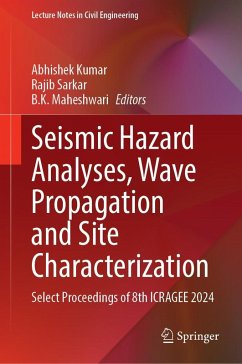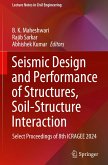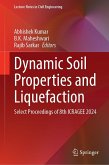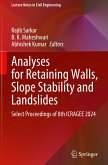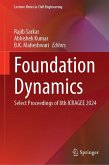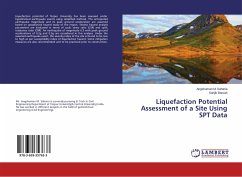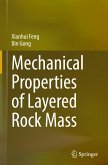Seismic Hazard Analyses, Wave Propagation and Site Characterization
Select Proceedings of 8th ICRAGEE 2024
Herausgegeben:Kumar, Abhishek; Sarkar, Rajib; Maheshwari, B.K.
Seismic Hazard Analyses, Wave Propagation and Site Characterization
Select Proceedings of 8th ICRAGEE 2024
Herausgegeben:Kumar, Abhishek; Sarkar, Rajib; Maheshwari, B.K.
- Gebundenes Buch
- Merkliste
- Auf die Merkliste
- Bewerten Bewerten
- Teilen
- Produkt teilen
- Produkterinnerung
- Produkterinnerung
This book will present the select proceedings of the 8th International Conference on Recent Advances in Geotechnical Earthquake Engineering and Soil Dynamics (8ICRAGEE) held at the Indian Institute of Technology (IIT), Guwahati between December 11 and 14, 2024. It contains the latest research papers covering the contributions and accomplishments in geotechnical earthquake engineering and soil dynamics in the last four years. The five volumes of the book cover a wide range of topics, including but not limited to seismic hazard analysis, wave propagation and site characterization, dynamic…mehr
Andere Kunden interessierten sich auch für
![Seismic Design and Performance of Structures, Soil-Structure Interaction Seismic Design and Performance of Structures, Soil-Structure Interaction]() Seismic Design and Performance of Structures, Soil-Structure Interaction174,99 €
Seismic Design and Performance of Structures, Soil-Structure Interaction174,99 €![Dynamic Soil Properties and Liquefaction Dynamic Soil Properties and Liquefaction]() Dynamic Soil Properties and Liquefaction174,99 €
Dynamic Soil Properties and Liquefaction174,99 €![Analyses for Retaining walls, Slope Stability and Landslides Analyses for Retaining walls, Slope Stability and Landslides]() Analyses for Retaining walls, Slope Stability and Landslides174,99 €
Analyses for Retaining walls, Slope Stability and Landslides174,99 €![Foundation Dynamics Foundation Dynamics]() Foundation Dynamics176,99 €
Foundation Dynamics176,99 €![Liquefaction Potential Assessment of a Site Using SPT Data Liquefaction Potential Assessment of a Site Using SPT Data]() Angshuman M. SahariaLiquefaction Potential Assessment of a Site Using SPT Data32,99 €
Angshuman M. SahariaLiquefaction Potential Assessment of a Site Using SPT Data32,99 €![Experimental and Theoretical Study on Thermal Consolidation Behavior of Saturated Clay Experimental and Theoretical Study on Thermal Consolidation Behavior of Saturated Clay]() Guangchang YangExperimental and Theoretical Study on Thermal Consolidation Behavior of Saturated Clay130,99 €
Guangchang YangExperimental and Theoretical Study on Thermal Consolidation Behavior of Saturated Clay130,99 €![Mechanical Properties of Layered Rock Mass Mechanical Properties of Layered Rock Mass]() Xianhui FengMechanical Properties of Layered Rock Mass123,99 €
Xianhui FengMechanical Properties of Layered Rock Mass123,99 €-
-
-
This book will present the select proceedings of the 8th International Conference on Recent Advances in Geotechnical Earthquake Engineering and Soil Dynamics (8ICRAGEE) held at the Indian Institute of Technology (IIT), Guwahati between December 11 and 14, 2024. It contains the latest research papers covering the contributions and accomplishments in geotechnical earthquake engineering and soil dynamics in the last four years. The five volumes of the book cover a wide range of topics, including but not limited to seismic hazard analysis, wave propagation and site characterization, dynamic properties and liquefaction of soils, pile foundations, offshore foundations, seismic design of retaining structures and dams, seismic slope stability and landslides, dynamic soil-structure interaction, seismic design of structures. Further, recent developments on these topics are covered in different chapters. This book will be valuable not only for researchers and professionals but also for drawing an agenda for future courses of action from the perspective of geotechnical earthquake engineering, keeping the national need at the forefront.
Produktdetails
- Produktdetails
- Lecture Notes in Civil Engineering 571
- Verlag: Springer / Springer Nature Singapore / Springer, Berlin
- Artikelnr. des Verlages: 978-981-96-1351-9
- Seitenzahl: 480
- Erscheinungstermin: 1. August 2025
- Englisch
- Abmessung: 241mm x 160mm x 30mm
- Gewicht: 911g
- ISBN-13: 9789819613519
- ISBN-10: 9819613515
- Artikelnr.: 72087305
- Herstellerkennzeichnung
- Springer-Verlag KG
- Sachsenplatz 4-6
- 1201 Wien, AT
- ProductSafety@springernature.com
- Lecture Notes in Civil Engineering 571
- Verlag: Springer / Springer Nature Singapore / Springer, Berlin
- Artikelnr. des Verlages: 978-981-96-1351-9
- Seitenzahl: 480
- Erscheinungstermin: 1. August 2025
- Englisch
- Abmessung: 241mm x 160mm x 30mm
- Gewicht: 911g
- ISBN-13: 9789819613519
- ISBN-10: 9819613515
- Artikelnr.: 72087305
- Herstellerkennzeichnung
- Springer-Verlag KG
- Sachsenplatz 4-6
- 1201 Wien, AT
- ProductSafety@springernature.com
Dr. Rajib Sarkar is currently working as an Associate Professor in the Department of Civil Engineering, IIT(ISM) Dhanbad. He has completed M.Tech and Ph.D. from IIT Roorkee. He is a recipient of the Engineering and Physical Sciences Research Council (EPSRC) fellowship for post-doctoral research at the University of Bristol, United Kingdom (UK). Dr. Sarkar has supervised five research scholars who have been awarded a Ph.D. degree and other six are in progress. His broad research area is geotechnical earthquake engineering. His core areas of research are soil-pile-structure interaction, liquefaction, seismic hazard analysis, and discrete element modelling. Dr. Sarkar has authored 53 refereed journal publications of international repute and 31 conference/symposium publications along with 13 book chapters. He is currently working on several research projects sponsored by the Science and Engineering Research Board (SERB), Ministry of Earth Sciences (MoES), Coal India Limited (CIL), National Disaster Management Authority (NDMA) amongst others. He has also completed several consultancy projects of national importance. He is also the Associate Editor of the Indian Society of Earthquake Technology's (ISET) Journal of Earthquake Technology. Dr. Sarkar has been awarded a gold medal by the University of North Bengal and the Indian Service of Engineers prize from IIT Roorkee. He is a recipient of the Best Ph.D. Thesis Award in Soil-Structure Interaction from the ISET. He has also received the Young Engineers Award from the Institution of Engineers, India in recognition of his contributions to the field of Civil Engineering. Prof. B.K. Maheshwari, is a Professor of Soil Dynamics in the Department of Earthquake Engineering, Indian Institute of Technology (IIT) Roorkee. Currently, he is also serving as a President of Indian Society of Earthquake Technology (ISET). Dr. Maheshwari completed his bachelor's degree in Civil Engineering from the University of Jodhpur, master's degree in Earthquake Engineering from the University of Roorkee and Ph.D. from the Saitama University Japan. He also worked as Engineer in Tokyo, Japan and then as a post-doctoral fellow at Washington University in St. Louis, Missouri, United States of America (USA). Prof. Maheshwari is serving as a faculty in IIT Roorkee since 2004. He has about 30 years of research experience and working in all areas of geotechnical earthquake engineering, particularly dynamic soil-structure interaction, liquefaction, dynamic soil properties, constitutive modelling, nonlinear finite element analysis, slope stability, landslides and disaster mitigation & management. He has published 190 research articles including 65 papers in journals of international repute. Under Prof. Maheshwari's guidance, ten Ph.D. theses were awarded and the other four are in progress. He worked on 8 sponsored research projects funded by the Department of Science and Technology (DST), the Ministry of Earth Sciences and the Norwegian Government. He has also worked on many industrial consultancy projects and carried out surveys for many damaging earthquakes. Prof. Maheshwari has been awarded a gold medal from the University of Roorkee, Monbusho Fellowship for Ph.D. in Japan and Engineer in Training (EIT) from Ohio State Board, USA. He has been awarded IIT Roorkee's prestigious Shamsher Prakash Research Award. He has also been awarded the Excellent Research Contribution Award by the International Association of Computer Methods and Advances in Geomechanics (IACMAG) in Kyoto, Japan. Prof. Maheshwari has served as the Head of the Centre of Excellence in Disaster Mitigation and Management, IIT Roorkee between 2015 to 2018. He was part of the delegation for the India-Japan High-Level Policy Dialogue on Education, led by the Secretary, Ministry of Human Resource Development (MHRD) to Tokyo, Japan in July 2016. Dr. Maheshwari was the Organizing Secretary for the prestigious 16th Symposium on Earthquake Engineering held in December 2018 at IIT Roorkee. He served as a Shamsher Prakash Chair Professor between 2019 to 2022. Recently, Prof. Maheshwari was awarded the John Booker Medal during the 16th International Conference of the International Association for Computer Methods and Advances in Geomechanics (IACMAG) held in Torino, Italy in September 2022. Currently he is serving as a Chair to organize 8th International Conference on Recent Advances in Geotechnical Earthquake Engineering (8ICARGEE) to be held in IIT Guwahati in December 2024. Dr. Abhishek Kumar is currently an Associate Professor at the Department of Civil Engineering at IIT Guwahati. Before joining IIT Guwahati in 2014, Dr Kumar also worked in Geostructure, Larsen and Toubro, Chennai office as Assistant Engineering Manager. His primary areas of research include seismic microzonation or urban centres, seismic source zonation, seismic hazard analysis, synthetic ground motion development, forward and inverse ground response analysis, stability analysis of Tailing pond embankment and ground improvement. He has so far guided 6 PhDs and many more are under progress. Dr. Kumar has published over 48 research papers in various reputed journals. He has also published over 43 conference papers and 7 book chapters. Dr. Kumar is a recipient of the Young Engineer Award from the Indian National Academy of Engineering in the area of Geotechnical Earthquake Engineering. He has also received the Innovation in Science Pursuit for Inspired Research (INSPIRE) faculty award from the Department of Science & Technology (DST) and the Young Engineer award from the Institution of Engineers, India. Dr. Kumar is the Subject Matter Expert from two NPTEL courses namely, 1) Subsurface exploration: Importance and Techniques involved; and 2) Applied Seismology for Engineers. Dr. Kumar has been working with different agencies including the Department of Science and Technology, Ministry of Earth Science, Nuclear Power Corporation of India Limited, National Highways & Infrastructure Development Corporation Limited (NHIDCL), JSW amongst others for various research and consultancy projects.
Chapter 1: Field and laboratory testing of soils for the estimation of dynamic soil properties.- Chapter 2. Latest findings on liquefaction of soils.- Chapter 3. Seismic slope stability and landslides.- Chapter 4. Seismic design of retaining walls, marine structures, and dams.- Chapter 5. Seismic design of shallow and deep foundations.- Chapter 6. Soil-structure interaction under dynamic loading.- Chapter 7. Engineering seismology, strong ground motions.- Chapter 8. Ground response analyses and local site effects.- Chapter 9. Seismic hazard analyses: zonation, microzonation, risk assessment.- Chapter 10. Ground improvement techniques for reduction of seismic hazard.- Chapter 11. Role of building codes in reduction of seismic risk.- Chapter 12. Wave propagation, engineering vibrations.- Chapter 13. Vibration problems of high-speed railways.- Chapter 14. Vibration absorption/isolation applications.- Chapter 15. Performance of constructed facilities in extreme events/case histories ofgeotechnical earthquake engineering.- Chapter 16. Reconnaissance reports of recent damaging earthquakes.- Chapter 17. GIS and remote sensing, AI/ ML applications for geo- hazards.- Chapter 18. Sensors and satellite technology for disaster management.Chapter 19. Seismic risk management and economics.- Chapter 20. Community preparedness and pre-earthquake disaster management.- Chapter 21. Innovative geotechnical applications in earthquake disaster management.- Chapter 22. Earthquake engineering education.- Chapter 23. Review of seismic design codes.
Chapter 1: Field and laboratory testing of soils for the estimation of dynamic soil properties.- Chapter 2. Latest findings on liquefaction of soils.- Chapter 3. Seismic slope stability and landslides.- Chapter 4. Seismic design of retaining walls, marine structures, and dams.- Chapter 5. Seismic design of shallow and deep foundations.- Chapter 6. Soil-structure interaction under dynamic loading.- Chapter 7. Engineering seismology, strong ground motions.- Chapter 8. Ground response analyses and local site effects.- Chapter 9. Seismic hazard analyses: zonation, microzonation, risk assessment.- Chapter 10. Ground improvement techniques for reduction of seismic hazard.- Chapter 11. Role of building codes in reduction of seismic risk.- Chapter 12. Wave propagation, engineering vibrations.- Chapter 13. Vibration problems of high-speed railways.- Chapter 14. Vibration absorption/isolation applications.- Chapter 15. Performance of constructed facilities in extreme events/case histories ofgeotechnical earthquake engineering.- Chapter 16. Reconnaissance reports of recent damaging earthquakes.- Chapter 17. GIS and remote sensing, AI/ ML applications for geo- hazards.- Chapter 18. Sensors and satellite technology for disaster management.Chapter 19. Seismic risk management and economics.- Chapter 20. Community preparedness and pre-earthquake disaster management.- Chapter 21. Innovative geotechnical applications in earthquake disaster management.- Chapter 22. Earthquake engineering education.- Chapter 23. Review of seismic design codes.

